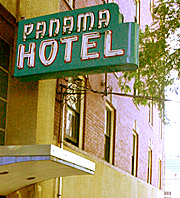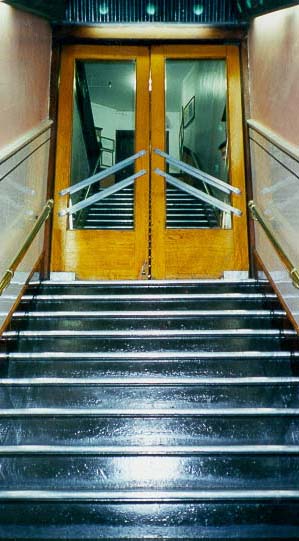


"It's so easy to laugh. It's so easy to hate. It takes strength to be gentle and kind." Trying, anyway.
 Here are some shots from Key West! Mostly El, as she is a much better photographer with a proper camera. Here am I, with a rental bike.
Here are some shots from Key West! Mostly El, as she is a much better photographer with a proper camera. Here am I, with a rental bike.  A characteristic Old Town cottage.
A characteristic Old Town cottage.  A typical residence in Old Town. Can you imagine a better place to finish a book?
A typical residence in Old Town. Can you imagine a better place to finish a book? All the gingerbread on the old Cigar-makers' cottages in Old Town corresponded to the people within. Wonder what this meant!
All the gingerbread on the old Cigar-makers' cottages in Old Town corresponded to the people within. Wonder what this meant! How often do you get to shout "Tin ROOF! Rusted" in unison? Not enough. Am thinking of buying this place, obviously.
How often do you get to shout "Tin ROOF! Rusted" in unison? Not enough. Am thinking of buying this place, obviously. "Breakfast with the roosters" at Blue Heaven restaurant. Seriously, the wild chickens are everywhere!
"Breakfast with the roosters" at Blue Heaven restaurant. Seriously, the wild chickens are everywhere! Banana bread (with the roosters) at Blue Heaven!
Banana bread (with the roosters) at Blue Heaven! Hemingway House!
Hemingway House! A six-toed cat at the Hemingway House. They're everywhere: even on Hemingway's bed.
A six-toed cat at the Hemingway House. They're everywhere: even on Hemingway's bed.  Hemingway's Study (I refuse to call him "Papa.")
Hemingway's Study (I refuse to call him "Papa.")  The sunset is a Big Deal in KW. Every night, everyone congregates at some bar (with obligatory guitar-strumming dude) to drink cocktails and celebrate the end of another day. Despite this, there was a shocking lack of good sunset-overlooking bars. And the "tiki bar" we found had not the faintest hint of a paper umbrella! Still, very pretty.
The sunset is a Big Deal in KW. Every night, everyone congregates at some bar (with obligatory guitar-strumming dude) to drink cocktails and celebrate the end of another day. Despite this, there was a shocking lack of good sunset-overlooking bars. And the "tiki bar" we found had not the faintest hint of a paper umbrella! Still, very pretty. Original Sponge Man!
Original Sponge Man!  This guy was in the garden of the Audubon House. The guide was very apologetic about the fact that Audubon had to shoot the birds in order to paint them, despite our reassurances that A) It was the 19th Century B) They were hardly endangered and C) It was for science. Made me worry about the caliber of the average tourist.
This guy was in the garden of the Audubon House. The guide was very apologetic about the fact that Audubon had to shoot the birds in order to paint them, despite our reassurances that A) It was the 19th Century B) They were hardly endangered and C) It was for science. Made me worry about the caliber of the average tourist. Pepe's, the oldest restaurant in Key West.
Pepe's, the oldest restaurant in Key West. This is an Ibis we saw on our tropical fruit bike tour (in which, yes, we did sample several novel fruits growing wild. We were the only members of the tour. The guide played "My Way" on a conch shell.)
This is an Ibis we saw on our tropical fruit bike tour (in which, yes, we did sample several novel fruits growing wild. We were the only members of the tour. The guide played "My Way" on a conch shell.)  The Southernmost point in the USA!
The Southernmost point in the USA! I know E will forgive my running a pic of her, since it is so neat! This tree, needless to say, is ancient! If we ever release a quirky album that gets play on Trouble's FMU show, this will be the cover art.
I know E will forgive my running a pic of her, since it is so neat! This tree, needless to say, is ancient! If we ever release a quirky album that gets play on Trouble's FMU show, this will be the cover art.

In the 1920's, Carl Tanzler (later known as Carl von Cosel) emigrated from Germany to the the Florida Keys, in the United States, leaving behind a wife and two young daughters. Von cosel had worked as an x-ray technician and inventor, barely making enough to get by, but claimed to be a former submarine skipper and owner of nine college degrees. In 1934, he found employment at a Key West hospital in the tuberculosis ward. Shortly after bring his family to join him in Florida, he and his wife, Doris, separated.
A recent author of the story, Ben Harrison, describes Tanzler at this stage of his life as; "fifty years old - an imaginative, impractical inventor, scientist, electrical wizard and sometimes ingenious liar" who had "already begun to mix fact and fantasy in the search for his dream lover." Von Cosel became a lonely man and his lonliness was transformed when he fixated when a new patient arrived at the hospital, suffering with the affliction.
A poor Hispanic 22-year-old young woman, Elena Hoyos, was universally acknowledged to be a great beauty and Von Cosel, then working as a ward technician, was soon captivated, despite her rebuffs of his advances. He quickly became determined to help Elena, even cure her, using unconventional methods. There is was never any evidence of a romance between the young hispanic beauty and Von Cosel, but in his mind and will, he intended to rid her of the disease, with the ultimate aim of forming a lasting love attachment.
Her desperate family, knowing the severity of her illness, gave Von Cosel permission to try his unusual methods in an attempt to cure her. The hospital staff was dubious but with his nine 'degrees' and ocassional eccentric brilliance, they let him try his approach on Elena, knowing they could do nothing themselves to sabe her. Using an odd mix of chemicals, herbs and even reportedly X-ray treatments, he attempted to stem the tide of her tuberculosis. It was sort of a an early attempt at chemotherapy, but with untried methods.
Despite his efforts, Elena Hoyos died leaving Von Cosel despondent and once again, alone. Von Cosel got permission from her family to build her a mausoleum. There, Von Cosel used formaldehyde and other chemicals and spices to preserve the body, secretly visiting it nightly. He had a key made that no one but her sister knew about. The Hoyos's trusted Von Cosel and since he seemed to love her in life (even though it was an unrequited love), they were understanding of his fondness for visiting her grave. They did not know he was inside attempting to preserve Elena. Von Cosel paid for and built an above-ground burial vault which included a telephone so that he could communicate with her and a strange airship whose function he refused to state. During these nightly visits, he would talk to Elena's corpse and said later that one night he saw her ghost in the mausoleum. He claimed she appeared to him from that time after every night and they would have long conversations and she expressed her love for him. These nocturmal visitations continuted for two years until he lost his job at the hospital and moved to a remote shack. But he wasn't alone in his shack, for he had stolen Elena's body from the mausoleum!
There he placed her body on a large bed, enough to sleep two, curtained with a cloth veil. He continued his work on her decaying body as the chemicals could only delay her body from mouldering for so long. He rubbed her entire body with strange oils and chemicals and then later had to reconstruct parts of her face with morticians wax to reform her features. He later admitted to spending long pleasant nights talking to her and professing his love.
Not seeing Von Cosel outside Elena's tomb for over seven years, her sister began to suspect something was amiss. She notified the authorities and they searched her mausoleum only to find it empty. Elena's sister instantly knew who had taken her sister's body and found Von Cosel's shack and confronted him. He kindly invited her inside, and to her horror, she saw what appeared be a wax dummy in the likeness of Elena laying on the bed. He told her that he and Elena were happy and in love and invited her to come back again and visit. The sister was livid and horrified and went to the police.
They came and took what they assumed to be a dummy to the local morgue to be autopsied. The "dummy" was actually the long decayed corpse of Elena Hoyos; her bones held together with piano wire, her skin had been treated with wax, her eye sockets filled with glass replacements, and she'd been perfumed to mask the odor of decomposition. This was terrible enough, but what the investigators found next was truly repulsive.
Von cosel had reconstructed many parts of her body, her eyes, nose, and most disturbingly, her vagina to which he added a tube that permitted sexual intercourse. He had been having sexual intercourse with the corpse of Elena Hoyos for as many as eight years!
The case eventually went to trial where amazingly the majority of the public, especially women, were firmly behind Carl, seeing him as a man who loved a woman so much that he was unable to let her go. In his confession he stated that he had planned to use the airship to take the both of them "high into the stratosphere, so that radiation from outer space could penetrate elena's tissues and restore life to her somnolent form." many people sympathized with von cosel after hearing his story and a latin love song was even composed based on the subject. Von cosel was only imprisoned for a short time and elena's body was buried in a metal cube which was buried in a secret location.
Before the burial there was another bizarre incident. So much attention had been given in newpapers, press accounts and court records that the authorities thought it would be best to show the people Elena's body before her secret burial. They placed her body, still grossly decayed and with a silken, waxy face, in a trailer cart and allowed the curious throngs to view her before her second burial. One ten-year-old boy, now in his 60's, said,
"I've never been able to forget that sight. It didn't even look like a human anymore. So much reconstrution and decay....it was the scariest thing I've ever seen. Her face was an odd white-ish color that looked more like a wax dummy than a womans face. And she had horrible, black, staring, glass eyes. I still dream about that sight."
It seems that the press did not divulge the details of the necrophilia before showing her corpse and had the general public known about that aspect there probably would have been less sympathy for Von Cosel. Declared sane, Von Cosel was not charged with a crime because the statute of limitations on grave robbing had expired. Elena Hoyos was eventually buried at a secret location. Von Cosel, separated from his love, used a death mask to create a life-sized dummy of her, and lived with it until his death in 1952.
Robert, sometimes known as Robert the Doll, is a doll that was once owned by Key West painter and author Robert Eugene Otto. The doll, which is allegedly cursed, has become a fixture of ghost tours in the Key West area since it was inducted into the Fort East Martello Museum. Aesthetically, Robert resembles an early 20th century American Naval officer. Contrary to popular belief, however, the doll's hair is not made of human hair, but rather, it consists of a synthetic material resembling wool yarn.
Eugene was given the doll in 1904 by a servant who, according to legend, was skilled in black magic and voodoo and was displeased with the family. Soon afterward it became clear that there was something eerie about the doll. Eugene's parents said they often heard him talking to the doll and that the doll appeared to be talking back. Although at first they assumed that Eugene was simply answering himself in a changed voice, they later believed that the doll was actually speaking.
Neighbors claimed to see the doll moving from window to window when the family was out. The Otto family swore that sometimes the doll would emit a terrifying giggle and that they caught glimpses of it running from room to room. In the night Eugene would scream, and when his parents ran to the room they would find furniture knocked over and Eugene in bed, looking incredibly scared, telling them that "Robert did it!".
When Eugene died in 1974, the doll was left in the attic until the house was bought again. The new family included a ten year old girl, who became Robert's new owner. It was not long before the girl began screaming out in the night, claiming that Robert moved about the room and even attempted to attack her on multiple occasions. More than thirty years later, she still tells interviewers that the doll was alive and wanted to kill her.
The doll is annually rotated to the Old Post Office and Customhouse in October, with museum staff claiming that strange activity in the museum increases during such times.
Individuals who desire to visit Robert in the Fort East Martello Museum and wish to take a picture of him, according to legend, the person must ask the doll politely, and if he does not agree (by tipping his head to one side) and the individual takes a picture anyway, then the doll will curse the person and their family.




"I don't know how you scientifically deal with that. I'm sure there are ways of saying that it was a bad dream or a projection, but it happens and it's not surprising believing in the communion of saints as I do. I think, "Yeah so? What's so surprising about it?" There's a fine line between the next world and this. It's all one reality and we can't divide it up, reality is reality. We know a little bit from Einstein about time, relativity and space, and that one interacts with the other. Time is a human construct anyway... who says there's a great division about past, present and future? Who says we can't visit those places in the so-called past? Now is all we have."










 Just finished A Novel Bookstore - which earlier, you'll recall, I was merely enjoying - and can now make my final recommendation, which is affirmative if somewhat qualified.
Just finished A Novel Bookstore - which earlier, you'll recall, I was merely enjoying - and can now make my final recommendation, which is affirmative if somewhat qualified.

When people talk about the gentrification of Williamsburg, they don't talk about what it has created, but only about the "bad things" it has replaced. For the gentrifiers, the former landscape needs to be destroyed, or at least gussied up beyond recognition—the past needs to be razed so a new culture can be overlaid, a culture that then celebrates its own superiority. To claim that gentrification has improved the community, Farr tells me, is "preposterous." How did the boutiques on Bedford Avenue make life better for the Latino community? Gentrification is not about what's been achieved but about the illusion that achievement has occurred. The idea. The feeling.



